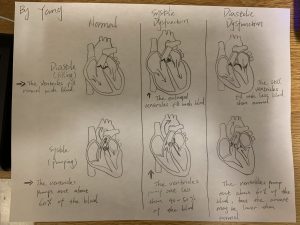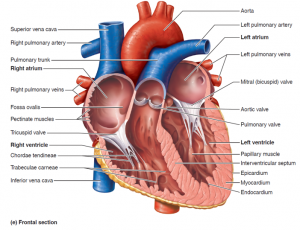Heart failure is the main topic of my steam project that I want to describe more about it. Basically, my steam project will cover heart failure types, the process of its anatomy description and its symptoms and treatments. It is known to us that the heart is important because it is a muscle that pumps oxygen-rich blood throughout the body via the circulatory system, delivering oxygen and nutrients to cells, tissues and organs and removing waster products. With heart failure, the heart is not able to pump enough oxygen-rich blood leaves the heart with each beat as well as it should. According to Villines Z (2016), there are two types of heart failure, which are systolic heart failure and diastolic heart failure. Both affect the ventricles’ ability to pump blood.
Firstly, we need to know that heart failure is a disorder in which the heart is unable to keep up with the demands of the body, leading to reduced blood flow, congestion of blood in the veins and lungs, and other changes that may further weaken or stiffen the heart (Jonathan G. Howlett, 2016). Meanwhile, heart failure is sometimes called congestive heart failure because blood may build up in the tissues, causing congestion in those tissues. Heart failure can occur in people of any age, even in young children, especially those born with a heart defect (Benjamin EJ, 2017). However, it is much more common among older, because older people are more likely to have disorders that predispose to heart failure, such as coronary artery disease, which will damage the heart muscle. Age-related changes in the heart also tend to make the heart work less efficiently (Benjamin EJ, 2017).
With the heart, the right side of the heart pumps blood from the veins into the lungs. The left side of the heart pumps blood from the lungs out through the arteries to the rest of the body. Normally, the main pumping chambers in the heart are the ventricles. Heart failure due to systolic dysfunction usually develops because the heart cannot contract normally. It may fill with blood, but the heart cannot pump out as much of the blood it contains because the muscle is weaker or because a heart valve malfunctions. As a result, the amount of blood pumped out to the body and to the lungs is reduced, and the ventricles usually enlarge (Jonathan G. Howlett. 2016). On the other hand, heart failure due to diastolic dysfunction develops because the heart muscle stiffens, which is particularly the left ventricle, and may thicken so that the heart cannot fill normally with blood. Consequently, blood backs up in the left atrium and pulmonary blood vessels and causes congestion. Nonetheless, the heart may be able to pump out a normal percentage of the blood it receives, but the total amount pumped out may be less. The heart chambers always contain some blood, but different amounts of blood may enter or leave the chambers with each heartbeat.
Accumulation of blood coming into the left side of the heart causes congestion in the lungs, making breathing difficult. Accumulation of blood coming into the right side of the heart causes congestion and fluid accumulation in other parts of the body, such as the legs and the liver. Heart failure usually affects both the right and left sides of the heart to some degree (Colucci WS, Dunlay SM, 2017). However, one side may be affected by disease more than the other. In such cases, heart failure may be described as right-side heart failure or left sided heart failure.
Nowadays, worldwide, about 26 million people are affected by heart failure. In the United States, about 6.5 million people have heart failure and about 960,000 new cases occur each year (Benjamin EJ, 2017). The disorder is likely to become more common because people are living longer and because, in some countries, certain risk factors for heart disease (such as obesity, diabetes, smoking, and high blood pressure) are affecting more people. Therefore, when you have heart failure, you need to pay close attention to your body and how you feel, every single day. That way, if a problem occurs, you can get help before it becomes too severe. You’ll need to watch for changes in your symptoms, such as rapid or irregular heartbeat, swelling (edema) in your legs, ankles and feet, persistent cough or wheezing with white or pink blood-tinged phlegm (Villines Z, 2016). As long as symptoms stay about the same from one day to the next, your heart failure is stable. But if symptoms start to get worse, it’s time to take some action. Although there is no cure for heart failure due to damaged heart muscle, many forms of treatment have been used to treat symptoms very effectively, such as medication, ventricular assist devices, implantable cardioverter defibrillator, and biventricular pacing therapy.
Although many people with heart failure live for many years, up to 70% of people die of the disorder within 10 years. Life expectancy depends on how severe the heart failure is, whether its cause can be corrected, and which treatment is used.
References
- Benjamin EJ, et al. Heart Disease and Stroke Statistics-2017 Update: A Report from the American Heart Association. Published March 7, 2017. Retrieved from https://www.ahajournals.org/doi/full/10.1161/CIR.0000000000000485.
- Jonathan G. Howlett. Heart Failure (HF) – Cardiovascular Disorders. Merck Manuals Professional Edition. Published March 1, 2016. Retrieved from https://www.merckmanuals.com/professional/cardiovascular-disorders/heart-failure/heart-failure-hf.
- Villines Z. Congestive heart failure: Stages, symptoms, and causes. Medical News Today. Published October 18, 2016. Retrieved from https://www.medicalnewstoday.com/articles/317848.
- Colucci WS, Dunlay SM. Clinical manifestations and diagnosis of advanced heart failure. UpToDate. Published June 14, 2017. Retrieved from https://www.uptodate.com/contents/clinical-manifestations-and-diagnosis-of-advanced-heart-failure.



Yang did his project on heart failure and the different types of heart failure that can occur. His drawings clearly show the vast differences in the quality of the ventricles as well as the blood flow that occurs with each type of cardiac failure. It is very interesting to note the arrows that he included to let the viewer know which way blood was pumping and it directed your eyes to the problem that was occurring with each image. His description was also very interesting and it included many credible and fascinating sources as well. From reading the paper that he submitted with his art piece, I learned that heart failure is a disorder in which someone’s heart begins to struggle to function therefore causing problems like congestion in the lungs and veins of the person, and after time this weakens the heart and lungs to the point of total dysfunction and eventually death. The two types of heart failure that yang included in his presentation are diastolic and systolic heart failure. Diastolic refers to the left ventricle thickening due to weakness and then the heart can no longer fill with blood at a normal rate/level. The opposite of this, systolic heart failure is when the heart no longer contracts the way it should and therefore the heart fills up with too much blood and is unable to pump it out fast enough. Because of this issue the lungs and other parts of the body do not receive blood quickly enough and they begin to weaken until they are no longer receiving blood flow. Yang’s project really demonstrated the different types of heart failure well and I appreciated how clear and concise his drawings all were.
Great work,
Miranda Lally